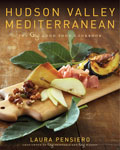The Real-Food Diet
How to Succeed in Eating Without Really Trying

Photo: Con Poulos
We've had it with the get-thin, get-healthy, look-younger plans that promise the moon. All we want is a sensible eating regimen that's easy to follow and makes us feel like a million bucks. What's the secret? Repeat after us: Eat your vegetables, whole grains, and fruits. Sure, it's a mantra you've heard before, but what you may not know is how to make following it tantalizingly easy: Nutritionist-turned-chef-turned-greenmarket-champion Laura Pensiero shows you how.
Working in the field of food and nutrition for almost 20 years, I have seen many "miracle" diets touted: high carb, low carb, low fat, high protein. During the same time, overweight and obesity rates have skyrocketed. But just telling people to eat healthier foods doesn't work, either. Despite national education campaigns designed to increase fruit and vegetable consumption, the Centers for Disease Control and Prevention has published data showing our national intake has actually declined slightly from the early '90s. How do we change this? People need strategies to help translate health information to the market and stovetop (see 6 Steps to Sustainable Eating for ideas).It's time to look at the problem from a different perspective. Eating well might require some adjustments, but trust me, none that hurt. The first step? Eat locally and seasonally. This is a natural, easy way to move toward better health and manage your weight. The reason is that locally raised food harvested at the pinnacle of ripeness will taste better, and if it tastes better, the pleasure of eating it goes way up. Biting into a mealy peach is a form of torture, after all. But a peach at its prime...that's bliss.
Feeling satisfied and well nourished is critical to making lasting changes. Face it, if you aren't enjoying yourself, you'll revert to old habits. So my second piece of advice is this: Don't do anything drastic. Don't feel you have to cut out food you love and then suffer and feel deprived. Instead, try putting more "good" food on your plate. Add a colorful vegetable to a familiar stew or sandwich , begin dinner with a great salad , or replace mashed potatoes with a whole grain pilaf. Get what you need not through duty but with pleasure.
I've long found that Mediterranean-style cooking offers the most enjoyable way to eat healthy. Since 2001 I've owned Gigi Trattoria in Rhinebeck, New York, and as a restaurateur, I've had a chance to share with customers my passion for foods made and harvested right here in my community. Recent research suggests that such ingredients are not just delicious but actually better for you than similar items grown halfway around the globe. Produce bred for long-distance shipping, for example, is likely to be lower in some nutrients and antioxidants. Most supermarket food travels an average of 1,500 miles after it is harvested. So calorie for calorie, locally grown food may offer more nourishment as well as more flavor.
During my four years as culinary coordinator at the Memorial Sloan Kettering Wellness and Prevention Center, I gave regular cooking demonstrations and saw firsthand how even dedicated meat-and-potato eaters respond to vegetables that have been cultivated and prepared with care. The usual wide-eyed response is, "I didn't think I would ever like that." That's the power of fresh food.
 Get the recipes:
Get the recipes: The Real-Food Diet Menu
From Hudson Valley Mediterranean: The Gigi Good Food Cookbook, by Laura Pensiero. Copyright (c) 2009 by Laura Pensiero. Published by William Morrow Cookbooks, an imprint of HarperCollins Publishers. Reprinted by permission.



